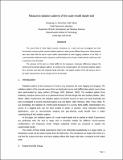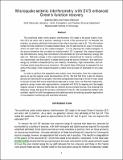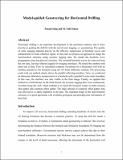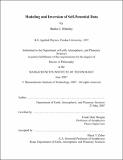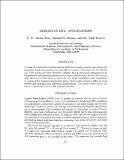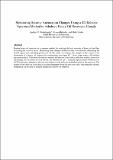Browsing Earth Resources Laboratory by Title
Now showing items 264-283 of 456
-
Measured radiation patterns of the scale model dipole tool
(Massachusetts Institute of Technology. Earth Resources Laboratory, 2003)The sound field of finite dipole acoustic transducers in a steel tool was investigated and their horizontal by measuring their vertical radiation patterns in water at two different frequencies. Measurements were also made ... -
Measurements Of Shear-Wave Azimuthal Anisotropy From Ultrasonic Dipole Data
(Massachusetts Institute of Technology. Earth Resources Laboratory, 1995)Four methods for analyzing azimuthal anisotropy from dipole logging data are described and attempted in this paper. These techniques are based on the phenomena of flexural wave splitting in anisotropic materials and are ... -
Measurements Of Shear-Wave Azimuthal Anisotropy With Cross-Dipole Logs
(Massachusetts Institute of Technology. Earth Resources Laboratory, 1997)Three methods for analyzing azimuthal anisotropy from cross-dipole logs are applied to data from the Powder River Basin in Wyoming. These techniques are based on the phenomena of flexural wave splitting in anisotropic ... -
Meeting Agenda
(Massachusetts Institute of Technology. Earth Resources Laboratory, 2007)Meeting agenda for the Earth Resources Laboratory 2007 Industry Consortia Meeting. -
A Method of Measuring Acoustic Wave Attenuation in the Laboratory
(Massachusetts Institute of Technology. Earth Resources Laboratory, 1987)The measurement of attenuation is performed by directly determining the attenuation operator (or the impulse response of the medium) in the time domain. In this way, it is possible to separate the attenuation operator ... -
Microquake seismic interferometry with SVD enhanced Green's function recovery
(Massachusetts Institute of Technology. Earth Resources Laboratory, 2011)The conditions under which seismic interferometry (SI) leads to the exact Green’s function (GF) are rarely met in practice, resulting in errors in the recovered GF. To alleviate this problem, we employ additional information ... -
Model-guided Geosteering for Horizontal Drilling
(Massachusetts Institute of Technology. Earth Resources Laboratory, 2009)Horizontal drilling is an important development in the petroleum industry and it relies heavily on guiding the drill bit with the aid of sonic logging, i.e. geosteering. The quality of sonic imaging depends heavily on ... -
Modeling and Inversion of Self Potential Data
(Massachusetts Institute of Technology. Earth Resources Laboratory, 2007-06)This dissertation presents data processing techniques relevant to the acquisition, modeling, and inversion of self-potential data. The primary goal is to facilitate the interpretation of self-potentials in terms of the ... -
Modeling Borehole Stoneley Wave Propagation Across Permeable In-Situ Fractures
(Massachusetts Institute of Technology. Earth Resources Laboratory, 1991)The characterization of hydraulic transmissivity of permeable fracture reservoirs is a very important task in the exploration of water resources and hydrocarbons. Previous studies that model the permeable structure as a ... -
Modeling Fluid Flow In Heterogeneous And Anisotropic Porous Media
(Massachusetts Institute of Technology. Earth Resources Laboratory, 1991)Permeability distribution in reservoirs is very important for the flow of water or oil and gas. In this study, the effects of various heterogeneous permeability distributions on the flow field are simulated using the finite ... -
Modeling of acoustic wave scattering from a two-dimensional fracture
(Massachusetts Institute of Technology. Earth Resources Laboratory, 2010)In this paper, we model the acoustic scattering from a two dimensional fracture that is simulated by two different physical models. We calculate the scattering from the fractures with different properties based on these ... -
Modeling Of Elastic Wave Propagation In A Fluid-Filled Borehole Excited By A Piezoelectric Transducer
(Massachusetts Institute of Technology. Earth Resources Laboratory, 1991)Acoustic logging is an important geophysical method for obtaining relevant information concerning rock properties in formations traversed by boreholes. Typically, the formation parameters that are measured are the ... -
Modeling Of Elastic Wave Propagation On Irregular Triangular Grids Using A Finite-Volume Method
(Massachusetts Institute of Technology. Earth Resources Laboratory, 1996)We present a finite-volume method for the modeling of wave propagation on irregular triangular grids. This method is based on an integral formulation of the wave equation via Gauss's theorem and on spatial discretization ... -
Modeling Of Seismoelectric Effects In A Borehole
(Massachusetts Institute of Technology. Earth Resources Laboratory, 1995)We present a method to simulate the propagation of seismic and converted electromagnetic waves generated by a mechanical borehole source embedded in a layered poroelastic medium. The electroseismic conversions occur at ... -
Modeling The Drag Forces Of Porous Media Acoustics
(Massachusetts Institute of Technology. Earth Resources Laboratory, 1992)The drag forces controlling the amount of relative flow induced in a fluid-saturated porous material by a mechanical wave are modeled here from first principles. Specifically, analytical expressions are derived for the ... -
Modelling Of Downhole Seismic Sources I: Literature Review, Review Of Fundamentals, Impulsive Point Source In A Borehole
(Massachusetts Institute of Technology. Earth Resources Laboratory, 1990)This paper represents the first of a two paper sequence comprising a multi-faceted introduction to the numerical and analytical modelling of seismic sources in a borehole. Part one will present a literature review and a ... -
Modelling Of Downhole Seismic Sources II: An Analysis Of The Heelan/Brekhovskikh Results And Comparison Of Point Source Radiation To Radiation From Boreholes
(Massachusetts Institute of Technology. Earth Resources Laboratory, 1990)The work of Heelan (1952, 1953a,b) was one of the first studies of wave propagation from a cylindrical boundary. Heelan attempted to model the radiation emanating from a cylindrical shot hole filled with dynamite. To do ... -
Modelling Of Full Waveform Acoustic Logs In Soft Marine Sediments
(Massachusetts Institute of Technology. Earth Resources Laboratory, 1986)Full waveform acoustic logs obtained from the Deep Sea Drilling Project (DSDP) were modelled using synthetic full waveform acoustic logs. These synthetic logs were calculated using the discrete wavenumber method. The model ... -
Models In LWD Applications
(Massachusetts Institute of Technology. Earth Resources Laboratory, 1999)A model for a fluid-filled borehole with an LWD tool is used to identify and analyze the monopole, dipole, and quadrupole modes that are present. The modes can be classified into three groups and have dispersion behavior ... -
Monitoring Seismic Attenuation Changes Using a 4D Relative Spectrum Method in Athabsca Heavy Oil Reservoir, Canada
(Massachusetts Institute of Technology. Earth Resources Laboratory, 2012)Heating heavy oil reservoirs is a common method for reducing the high viscosity of heavy oil and thus increasing the recovery factor. Monitoring these changes in the reservoir is essential for delineating the heated region ...

